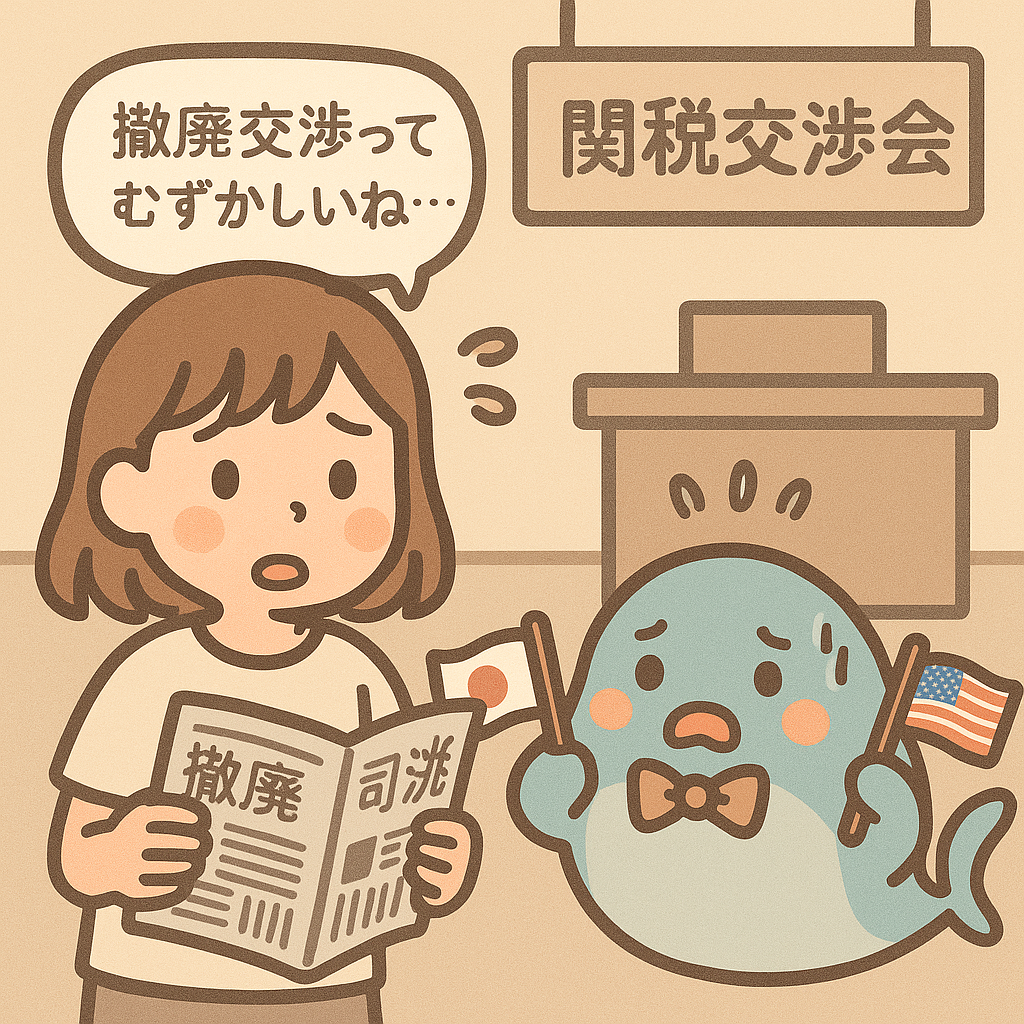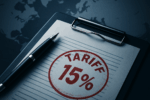記事まとめ
トランプ米政権の関税措置見直しを巡る日米交渉において、米側が日本に課している相互関税の上乗せ分について、引き下げに柔軟な姿勢を示していることが明らかになった。この相互関税は、米国が安全保障上の脅威に対処する国際緊急経済権限法(IEEPA)に基づき、4月に導入した措置である。一律10%の基本税率と、国・地域ごとに異なる上乗せ分で構成されており、日本の上乗せ分は14%となっている。現在この上乗せ分は7月9日まで90日間停止されているが、停止期間が終了し全面適用されれば税率は24%となり、幅広い国内産業が打撃を受ける恐れがある。
日本側は自動車や鉄鋼・アルミニウムの追加関税を含む一連の措置の撤廃を一貫して求めているのに対し、米国は相互関税の上乗せ部分を主な交渉対象とする姿勢を示してきた。米側が上乗せ部分引き下げに応じても、各国一律で課される10%の基本税率部分は残るとの見方も出ている。両国の隔たりは依然として大きく、調整は難航も予想される。
赤沢亮正経済再生担当相は5回目の閣僚級交渉のためワシントンを訪問し、「貿易の拡大、非関税措置、経済安全保障上の協力などについてさらに議論を深める」と強調した。日本は今月中旬の先進7カ国首脳会議(G7サミット)に合わせた日米首脳会談での合意を視野に歩み寄りを探っている。
日本側は、貿易の拡大、非関税措置、経済安全保障面での協力などを軸に交渉を重ねてきた。具体的には、米国産車を日本に輸出しやすくするよう、安全基準面の認証制度を見直す案などを提示している。輸入拡大を通じて米国の対日貿易赤字圧縮を促すことで米側の理解を得たい考えだ。
English Translation
In the ongoing negotiations between Japan and the United States regarding the review of tariff measures imposed by the Trump administration, it has been revealed that the U.S. side is showing flexibility on reducing the additional tariffs imposed on Japan. These mutual tariffs were introduced in April based on the International Emergency Economic Powers Act (IEEPA), which the U.S. invoked to address alleged security threats. The tariffs consist of a uniform 10% basic rate and an additional rate that varies by country or region, with Japan’s additional rate being 14%. Currently, this additional rate has been suspended for 90 days until July 9, but if the suspension period ends and the tariffs are fully implemented, the rate will increase to 24%, potentially causing significant damage to a wide range of Japanese industries.
While Japan has consistently demanded the complete elimination of a series of measures, including additional tariffs on automobiles, steel, and aluminum, the United States has maintained its stance that the additional portion of the mutual tariffs should be the main focus of negotiations. Even if the U.S. agrees to reduce the additional portion, the view is that the 10% basic rate uniformly imposed on all countries will remain. The gap between the two countries remains significant, and negotiations are expected to be difficult.
Ryosei Akazawa, Japan’s Minister for Economic Revitalization, visited Washington for the fifth ministerial-level talks, emphasizing that they would “further deepen discussions on trade expansion, non-tariff measures, and cooperation on economic security.” Japan is seeking to find common ground with an eye on reaching an agreement at the Japan-U.S. summit meeting to be held in conjunction with the G7 Summit in mid-June.
Japan has been conducting negotiations centered on trade expansion, non-tariff measures, and cooperation in economic security. Specifically, Japan has proposed measures such as revising certification systems for safety standards to make it easier to export American cars to Japan. The Japanese side hopes to gain U.S. understanding by encouraging a reduction in the U.S. trade deficit with Japan through increased imports.
英語学習ポイント
この記事には、国際経済や貿易交渉に関する重要な英語表現が多く含まれています。特に注目すべき表現を見ていきましょう。
重要単語・表現
- tariff measures (関税措置) – 国際貿易において国が課す税金のこと
- flexibility (柔軟性) – 交渉の文脈では「譲歩する姿勢」を示す重要な表現
- International Emergency Economic Powers Act (国際緊急経済権限法) – 米国の法律で、国家安全保障上の脅威に対処するために経済的措置を取る権限を大統領に与える法律
- invoke (発動する) – 法律や権限を正式に使用すること
- suspension period (停止期間) – 一時的に効力を停止している期間
- ministerial-level talks (閣僚級会談) – 各国の大臣同士による高位レベルの交渉
- trade deficit (貿易赤字) – ある国が別の国との貿易で輸入が輸出を上回る状態
文法・構文解説
1. “It has been revealed that the U.S. side is showing flexibility…”
この文は「it has been revealed that…」という構文を使っています。これは「〜ということが明らかになった」という意味で、形式主語 “it” を使った受動態の表現です。ニュース記事でよく使われる客観的な表現方法です。
2. “These mutual tariffs were introduced in April based on the International Emergency Economic Powers Act…”
この文では “based on” という前置詞句が使われています。「〜に基づいて」という意味で、根拠や理由を示す際によく使われます。
3. “…if the suspension period ends and the tariffs are fully implemented, the rate will increase to 24%…”
この文は条件文(if節)を使った構文です。「もし〜ならば、〜するでしょう」という未来の可能性を示しています。ビジネスや経済ニュースでは、このような条件付きの予測がよく使われます。
4. “Japan is seeking to find common ground with an eye on reaching an agreement…”
“with an eye on ~” は「〜を視野に入れて」という意味のイディオム表現です。目標や将来の展望を示す際に使われます。また、”seeking to find” は「見つけようと努めている」という継続的な行動を表現しています。
対談: 関税交渉の英語表現を学ぼう
![]() エイングリッシュ: みなさん、こんにちはエイ!今日は国際経済のホットトピック、日米の関税交渉について英語で学んでいくエイ。ふうかさんも一緒に勉強していきましょうエイ!
エイングリッシュ: みなさん、こんにちはエイ!今日は国際経済のホットトピック、日米の関税交渉について英語で学んでいくエイ。ふうかさんも一緒に勉強していきましょうエイ!
 ふうかさん: こんにちは〜!関税ってタックスのことですよね?私、タックスって言葉、アメリカドラマでよく聞くけど、「タックスリターン」とか言ってるやつですよね?
ふうかさん: こんにちは〜!関税ってタックスのことですよね?私、タックスって言葉、アメリカドラマでよく聞くけど、「タックスリターン」とか言ってるやつですよね?
![]() エイングリッシュ: その通りエイ!でも今日話すのは普通の「tax(税金)」ではなく「tariff(関税)」についてエイ。関税は特に輸入品に課される税金のことエイ。日本語では両方とも「税」という言葉が入るけど、英語では全く異なる単語なんだエイ。
エイングリッシュ: その通りエイ!でも今日話すのは普通の「tax(税金)」ではなく「tariff(関税)」についてエイ。関税は特に輸入品に課される税金のことエイ。日本語では両方とも「税」という言葉が入るけど、英語では全く異なる単語なんだエイ。
 ふうかさん: へー!そうなんですね。ってことは、アメリカが日本の商品に課してる税金が「tariff」で、日本国内で私たちが払う消費税は「tax」ってことですか?
ふうかさん: へー!そうなんですね。ってことは、アメリカが日本の商品に課してる税金が「tariff」で、日本国内で私たちが払う消費税は「tax」ってことですか?
![]() エイングリッシュ: その理解で正確エイ!記事の中で “mutual tariffs”(相互関税)という表現が出てきたけど、これは互いの国が相手国の製品に課す関税のことエイ。
エイングリッシュ: その理解で正確エイ!記事の中で “mutual tariffs”(相互関税)という表現が出てきたけど、これは互いの国が相手国の製品に課す関税のことエイ。
 ふうかさん: なるほど〜。でもこの記事って、アメリカが日本に「flexibility」を見せてるって書いてありますよね?これって、アメリカが「柔軟になったよ〜」って言ってるってことですか?
ふうかさん: なるほど〜。でもこの記事って、アメリカが日本に「flexibility」を見せてるって書いてありますよね?これって、アメリカが「柔軟になったよ〜」って言ってるってことですか?
![]() エイングリッシュ: そうエイ!”showing flexibility” は「柔軟な姿勢を示している」という意味エイ。交渉の場面では、相手の要求に対して少し譲歩する姿勢を示すときによく使われる表現エイ。
エイングリッシュ: そうエイ!”showing flexibility” は「柔軟な姿勢を示している」という意味エイ。交渉の場面では、相手の要求に対して少し譲歩する姿勢を示すときによく使われる表現エイ。
 ふうかさん: わかりました!じゃあ私が友達とラーメン二郎に行くか行かないか交渉するとき、「I’m showing flexibility on going to Ramen Jiro today」って言えばいいんですね!
ふうかさん: わかりました!じゃあ私が友達とラーメン二郎に行くか行かないか交渉するとき、「I’m showing flexibility on going to Ramen Jiro today」って言えばいいんですね!
![]() エイングリッシュ: まあ、使えなくはないけど、ちょっと硬い表現エイ…。日常会話なら “I can be flexible about going to Ramen Jiro” の方が自然エイ。ビジネスや外交の場面で使われることが多い表現エイ。
エイングリッシュ: まあ、使えなくはないけど、ちょっと硬い表現エイ…。日常会話なら “I can be flexible about going to Ramen Jiro” の方が自然エイ。ビジネスや外交の場面で使われることが多い表現エイ。
対談: 条件文で経済予測を表現しよう
![]() エイングリッシュ: 次は条件文について見ていくエイ。記事中に “if the suspension period ends and the tariffs are fully implemented, the rate will increase to 24%” という文があったエイ。
エイングリッシュ: 次は条件文について見ていくエイ。記事中に “if the suspension period ends and the tariffs are fully implemented, the rate will increase to 24%” という文があったエイ。
 ふうかさん: if…って英語の授業で習った気がします!「もし〜なら」っていう意味ですよね。
ふうかさん: if…って英語の授業で習った気がします!「もし〜なら」っていう意味ですよね。
![]() エイングリッシュ: その通りエイ!この文は「もし停止期間が終了し、関税が完全に実施されれば、税率は24%に上昇するだろう」という意味エイ。経済ニュースではこういう条件文がよく使われるエイ。
エイングリッシュ: その通りエイ!この文は「もし停止期間が終了し、関税が完全に実施されれば、税率は24%に上昇するだろう」という意味エイ。経済ニュースではこういう条件文がよく使われるエイ。
 ふうかさん: あ、「もしこうなったら、こうなるよ」っていう予測を言うときに使うんですね!じゃあ「If I eat at Ramen Jiro, I will gain weight」とか言えるんですか?
ふうかさん: あ、「もしこうなったら、こうなるよ」っていう予測を言うときに使うんですね!じゃあ「If I eat at Ramen Jiro, I will gain weight」とか言えるんですか?
![]() エイングリッシュ: 完璧エイ!それは正しい条件文の使い方エイ。現実的な条件と結果を表すときは「If + 現在形, will + 動詞の原形」という形を使うエイ。
エイングリッシュ: 完璧エイ!それは正しい条件文の使い方エイ。現実的な条件と結果を表すときは「If + 現在形, will + 動詞の原形」という形を使うエイ。
 ふうかさん: なるほど!でも、本当はラーメン二郎毎日食べたいんですけど、太るのは嫌だなぁ…。「If I could eat Ramen Jiro without gaining weight, I would be happy」とか言えますか?
ふうかさん: なるほど!でも、本当はラーメン二郎毎日食べたいんですけど、太るのは嫌だなぁ…。「If I could eat Ramen Jiro without gaining weight, I would be happy」とか言えますか?
![]() エイングリッシュ: おお!それは第2条件文と呼ばれるもので、現実にはあまりありえない状況を表すときに使うエイ。「If + 過去形, would + 動詞の原形」という形になるエイ。完璧な例文エイ!
エイングリッシュ: おお!それは第2条件文と呼ばれるもので、現実にはあまりありえない状況を表すときに使うエイ。「If + 過去形, would + 動詞の原形」という形になるエイ。完璧な例文エイ!
 ふうかさん: わー、すごい!偶然当たっちゃいました!でも、条件文って経済ニュースでよく使われるんですね。
ふうかさん: わー、すごい!偶然当たっちゃいました!でも、条件文って経済ニュースでよく使われるんですね。
![]() エイングリッシュ: そうエイ!経済は予測が大事だからエイ。「もしこうなれば、こうなるだろう」という表現が多いエイ。
エイングリッシュ: そうエイ!経済は予測が大事だからエイ。「もしこうなれば、こうなるだろう」という表現が多いエイ。
対談: 貿易交渉で使われる英語イディオム
![]() エイングリッシュ: 最後に、記事中のイディオム表現について見ていくエイ。”Japan is seeking to find common ground with an eye on reaching an agreement” という文があったエイ。
エイングリッシュ: 最後に、記事中のイディオム表現について見ていくエイ。”Japan is seeking to find common ground with an eye on reaching an agreement” という文があったエイ。
 ふうかさん: おお!難しそう!「common ground」って「共通の地面」ってことですか?公園とか?
ふうかさん: おお!難しそう!「common ground」って「共通の地面」ってことですか?公園とか?
![]() エイングリッシュ: いや、それは文字通りの意味ではないエイ。”find common ground” は「共通点を見つける」「合意点を見いだす」という意味のイディオムエイ。交渉において、お互いが受け入れられる解決策を見つけることを指すエイ。
エイングリッシュ: いや、それは文字通りの意味ではないエイ。”find common ground” は「共通点を見つける」「合意点を見いだす」という意味のイディオムエイ。交渉において、お互いが受け入れられる解決策を見つけることを指すエイ。
 ふうかさん: なるほど!じゃあ友達とラーメン二郎と牛丼屋のどっちに行くか揉めたとき、「Let’s find common ground」って言えばいいんですね!
ふうかさん: なるほど!じゃあ友達とラーメン二郎と牛丼屋のどっちに行くか揉めたとき、「Let’s find common ground」って言えばいいんですね!
![]() エイングリッシュ: その通りエイ!ただし、ちょっとフォーマルな表現なので、友達同士の会話では “Let’s compromise” や “Let’s meet in the middle” の方がよく使われるエイ。
エイングリッシュ: その通りエイ!ただし、ちょっとフォーマルな表現なので、友達同士の会話では “Let’s compromise” や “Let’s meet in the middle” の方がよく使われるエイ。
 ふうかさん: じゃあ、”with an eye on” の部分はどういう意味なんですか?目がついてるってこと?
ふうかさん: じゃあ、”with an eye on” の部分はどういう意味なんですか?目がついてるってこと?
![]() エイングリッシュ: これも文字通りの意味ではないエイ。”with an eye on” は「〜を視野に入れて」「〜を目標にして」という意味のイディオムエイ。何か目標や将来の展望を持って行動することを表すエイ。
エイングリッシュ: これも文字通りの意味ではないエイ。”with an eye on” は「〜を視野に入れて」「〜を目標にして」という意味のイディオムエイ。何か目標や将来の展望を持って行動することを表すエイ。
 ふうかさん: へー!じゃあ「I’m saving money with an eye on buying a new computer」とか言えるんですね!
ふうかさん: へー!じゃあ「I’m saving money with an eye on buying a new computer」とか言えるんですね!
![]() エイングリッシュ: 完璧エイ!その例文は素晴らしいエイ!
エイングリッシュ: 完璧エイ!その例文は素晴らしいエイ!
 ふうかさん: わあ!ありがとうございます!でも実は今、ラーメン二郎のために貯金してるんです。「I’m saving money with an eye on eating Ramen Jiro’s mega pork bowl, because if I find common ground with my stomach, I will show flexibility on my diet!」
ふうかさん: わあ!ありがとうございます!でも実は今、ラーメン二郎のために貯金してるんです。「I’m saving money with an eye on eating Ramen Jiro’s mega pork bowl, because if I find common ground with my stomach, I will show flexibility on my diet!」
![]() エイングリッシュ: ちょっと待て!それ全部の表現をごちゃ混ぜにしてるし、ラーメン二郎にメガ豚丼なんてメニューないだろ!
エイングリッシュ: ちょっと待て!それ全部の表現をごちゃ混ぜにしてるし、ラーメン二郎にメガ豚丼なんてメニューないだろ!
確認テスト
今回学んだ表現を確認するため、以下の問題に挑戦してみましょう。
- 「関税」を意味する英単語は?
a) Tax
b) Tariff
c) Duty
d) Levy - 次の英文の空欄に入る最も適切な表現は?
“The United States is ________ on reducing the additional tariffs.”
a) showing rigidity
b) showing flexibility
c) making eyes
d) taking grounds - 「もし停止期間が終了すれば、税率は上昇するだろう」を英語で表現すると?
a) If the suspension period ends, the rate would increase.
b) If the suspension period will end, the rate increases.
c) If the suspension period ended, the rate will increase.
d) If the suspension period ends, the rate will increase. - “find common ground” の意味として最も適切なのは?
a) 共通の土地を見つける
b) 同じ場所を見つける
c) 合意点を見いだす
d) 共通の敵を見つける - “with an eye on” の意味として最も適切なのは?
a) 目を開けて
b) 〜を視野に入れて
c) 目で確認して
d) 注目を集めて
※解答は下にあります(同じ背景色で表示されているため見えませんが、選択すると表示されます)
1. b) Tariff
2. b) showing flexibility
3. d) If the suspension period ends, the rate will increase.
4. c) 合意点を見いだす
5. b) 〜を視野に入れて


















